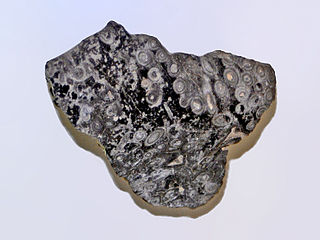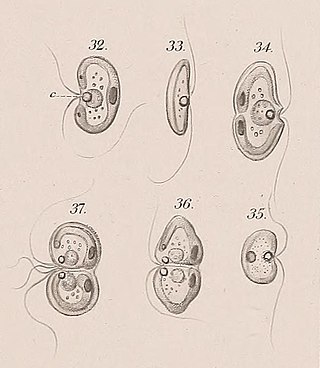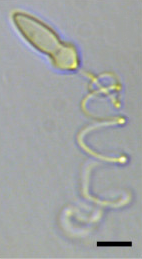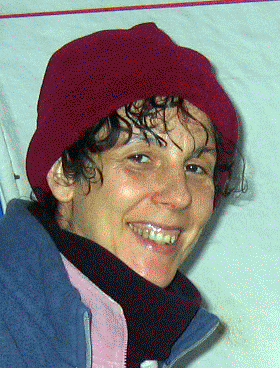Related Research Articles

The Dasycladaceae is one of the two extant families of green algae of the order Dasycladales. When found in Palaeozoic limestones, they typically indicate depositional depth of less than 5m.

Neochloridaceae is a family of green algae in the order Sphaeropleales.

Acrochaete is a genus of marine green algae of the family Ulvellaceae known to live as endoparasites of other algae, although they may eventually be found growing on inorganic substrates, such as rocks.

Nephroselmis is a genus of green algae. It has been placed in the family Nephroselmidaceae, although a 2009 study suggests that it should be separated into its own class, Nephroselmidophyceae. One species can be an endosymbiont of Hatena arenicola.
Pseudomuriella is a genus of green algae, specifically of the class Chlorophyceae. It is the sole genus of the family Pseudomuriellaceae. It is a terrestrial alga that inhabits soils.

Pseudopediastrum is a genus of green algae in the family Hydrodictyaceae. It is very common in freshwater regions throughout the world.

The Klebsormidiaceae are a family containing five genera of charophyte green alga forming multicellular, non-branching filaments. The genus Chlorokybus was previously included as well, but this problematic and poorly known genus is now placed in a separate class Chlorokybophyceae.

Karlodinium is a genus of athecate dinoflagellates that lives worldwide. They are often toxin producing, and compared to the other members of the Kareniaceae, are fairly small at <8-15 μm diameter. They are also able to form intense algal blooms. This species relies of photosynthesis and phagotrphy to grow.

Phacus is a genus of unicellular excavates, of the phylum Euglenozoa, characterized by its flat, leaf-shaped structure, and rigid cytoskeleton known as a pellicle. These eukaryotes are mostly green in colour, and have a single flagellum that extends the length of their body. They are morphologically very flat, rigid, leaf-shaped, and contain many small discoid chloroplasts.

Polykrikos kofoidii is a species of phagotrophic marine pseudocolonial dinoflagellates that can capture and engulf other protist prey, including the toxic dinoflagellate, Alexandrium tamarense. P. kofoidii is of scientific interest due to its status as a predator of other dinoflagellates, a behavior that is significant in the control of algal blooms. It has a complex life cycle of both vegetative (asexual) and sexual reproduction complicated by its pseudocolonial structure.
Karlodinium antarcticum is a species of unarmored dinoflagellates from the genus Karlodinium. It was first isolated from the Australian region of the Southern Ocean, near the polar front. It is medium-sized and is characterized by its long ovoid cell shape and rather long apical groove. It is considered potentially ichthyotoxic.
Karlodinium corrugatum is a species of unarmored dinoflagellates from the genus Karlodinium. It was first isolated from the Australian region of the Southern Ocean, just south of the polar front. It is small-sized and is characterized by having distinctive striations on the epicone surface which are parallel, and a distinctively shaped and placed ventral pore. It is considered potentially ichthyotoxic.
Karlodinium decipiens is a species of unarmored dinoflagellates from the genus Karlodinium. It was first isolated from the Australian region of the Southern Ocean, but has a widespread distribution, through the Southern Ocean to the Tasman Sea, to the coast of Spain. It is large-sized and is characterized by having a helicoidal chloroplast arrangement and a big central nucleus. It is considered potentially ichthyotoxic.

The Polykrikaceae are a family of athecate dinoflagellates of the order Gymnodiniales. Members of the family are known as polykrikoids. The family contains two genera: Polykrikos and Pheopolykrikos.

Annick Wilmotte is a Belgian Antarctic researcher best known for her research on the diversity and ecology of Antarctic cyanobacterial microflora. A genus of Antarctic cyanobacteria called Wilmottia was named after her in recognition of her work in this field.

Batrachospermaceae is a family of fresh water red algae (Rhodophyta). Genera within the Batrachospermaceae generally have a "Lemanea-type" life history with carpospores germinating to produce chantransia. Sporophyte phase with meiosis occurs in an apical cell to produce the gametophyte stage. Pit connections have two pit plug cap layers with the other layer enlarged. This family of freshwater red algae is uniaxial, meaning each filament with a single apical cell. The genera included within Batrachospermaceae are listed in the table below.

Biddulphiaceae is a family of diatom, the only family in the order Biddulphiales. The Biddulphiaceae are distinguished from the Eupodiscaceae by their pseudocelli, where the Eupodiscaceae have fully developed ocelli. Both families commonly inhabit the littoral zone of the ocean, close to the shore. Sixteen species of Biddulphiaceae are found on the west coast of India.

Timothy (Tim) John Entwisle, is an Australian botanist, much of whose research work is in phycology (algae). See for example the articles. He was awarded a Ph.D. from La Trobe University in 1986 for work on the taxonomy of Vaucheria.
Karlodinium armiger is a species of dinoflagellates belonging to the family Kareniaceae. It was first isolated from the Mediterranean sea & described in 2006.
Ethmodiscus is a genus of diatoms found widely scattered throughout the intertropical and temperate zones in the world's oceans. The large diatom genus can get up to 2mm in size, and it has distinct cell features like a vacuole that comprises over 99% of its cell's volume. Despite their large size, they are known to be in open oceans in low quantity. While in the ocean, Ethmodiscus use buoyancy control to migrate up and down to the high nitrogen depths and return to the surface to photosynthesize. Additionally, the biological characteristics of Ethmodiscus are an important component in interpreting deep-sea sedimentary richness and distribution.
References
- 1 2 Strunecký, Otakar; Ivanova, Anna Pavlovna; Mareš, Jan (February 2023). "An updated classification of cyanobacterial orders and families based on phylogenomic and polyphasic analysis". Journal of Phycology. 59 (1): 12–51. doi:10.1111/jpy.13304. ISSN 1529-8817. PMID 36443823.
- 1 2 "Erratum". Journal of Phycology. 59 (3): 635–635. June 2023. doi:10.1111/jpy.13355. ISSN 1529-8817. PMID 37313842.
- 1 2 "Family Aerosakkonemataceae". LPSN - List of Prokaryotic names with Standing in Nomenclature. Retrieved 15 July 2024.